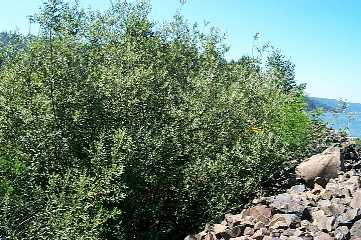
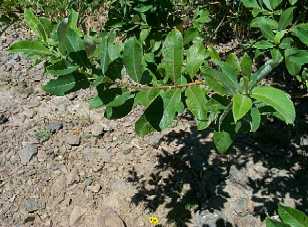
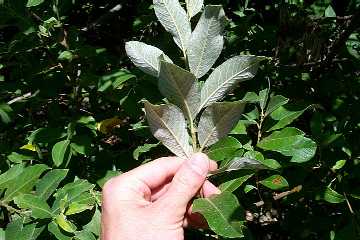
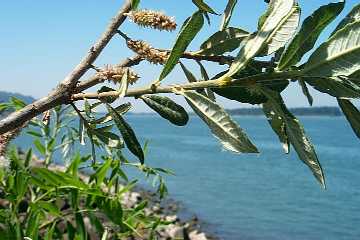
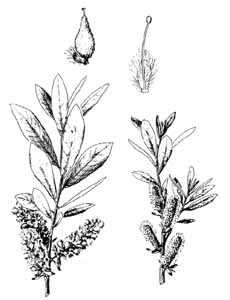
General Species Description.
- Sitka willow is a multi-stemmed shrub which grows up to eight meters tall. It is one of the most common willows in our region. The bark is gray to dark brown and smooth. Young twigs are usually densely velvety-short-hairy. Round galls that are red above and green below are common.
Leaves
- Leaf buds are erect and cylindrical, with a rounded tip. They have longitudinal grooves facing the twig, and are densely covered by forward pointing short hairs. The undersized leaves are densely covered in unidirectional hairs which give the leaf a nap that reflects light when rotated. Leaves are 3.5 - 10 centimeters long and 1.8 - 3.5 centimeters wide. They are two to four times as long as wide. Leaf stalks are 5- 15 millimeters long. Leaves are oblong-lance-shaped with smooth margins. They occasionally have a few scattered callous glands. They are widest at the tip.
Inflorescence/Flowers
- Blooms occur March through April. Catkins appear with or before the leaves. They are on stems which are about one centimeter long. Male catkins are 2.5 - 5 millimeters long and 1 - 1.5 centimeters wide. They are brown or the base light colored. They have one stamen and no hairs. Female catkins are three to eight centimeters long, and are two centimeter thick. The capsules are 3 - 5.5 millimeters long, densely short hairy, and have hairs more or less forward-pointing. The style is 0.3 - 0.8 millimeters long. The stigma is stubby, and the stipe is short (less than 1 millimeter). Floral bracts are black, occasionally brown or the base light colored, long-hairy, two millimeters long and persistent.
Habitat
- Sitka willow is common in many habitat types, including sandy floodplains, gravel shores, and muddy stream banks. It is a weedy species and will invade wet areas such as ditches, stream banks, and cleared wetlands. It is occasionally found on drier sites.
Range
- Found from the coast of Alaska to San Louis Obispo California; west Cascades, eastern Oregon north to British Columbia.
Similar Species
- Sitka willow is readily recognized by how light reflects differently underneath the leaf. No other species has hairs that do this. Scouler willow (Salix scouleriana) has similar leaves, but catkins appear before the leaves, stigmas are long, capsules are large, and the hairs fall off on the underside of the older leaves except along the veins where they are rusty-red. In addition, it blooms in February.
Ecological Value
- In general, willows are highly favored by wildlife in this area. Willow buds are eaten by birds and small mammals. Deer and elk eat the twigs and leaves. Rabbits, mice and beavers eat the bark. Beavers use willows to build their dams. Willows are often the dominant stream bank plants where they prevent erosion by stabilizing the banks and providing nesting habitat for birds and mammals. Willows also shade stream banks, enhancing fish habitat. Willow leaves provide a food source for aquatic bacteria during the fall and winter. The decaying leaves provide nutrients for the aquatic food chain.
Human Value
- In general, willows are used for ornamental plantings near water sources. They bloom early, can be used as shade trees, and the "pussy willows" (unopened male catkins) are used for decoration. Mecerated willow wood contains a plant hormone that stimulates root growth. Native people of western Washington and Oregon used willow wood for construction and fibers were used for fishing and hunting.
References
- Cooke, S. S., ed. 1997. A Field Guide to the Common Wetland Plants of Western Washington & Northwest Oregon.
Seattle Audubon Society and Washington Native Plant Society. Seattle Audubon Society, Seattle WA, 74 p.
Hitchcock, C. L. and A. Cronquist. 1973. Flora of the Pacific Northwest. University of Washington Press, Seattle WA, 70 p.
This page was created by: Marshall Johnson, August 8, 2000
Return to Northwest Oregon Wetland Plants Project